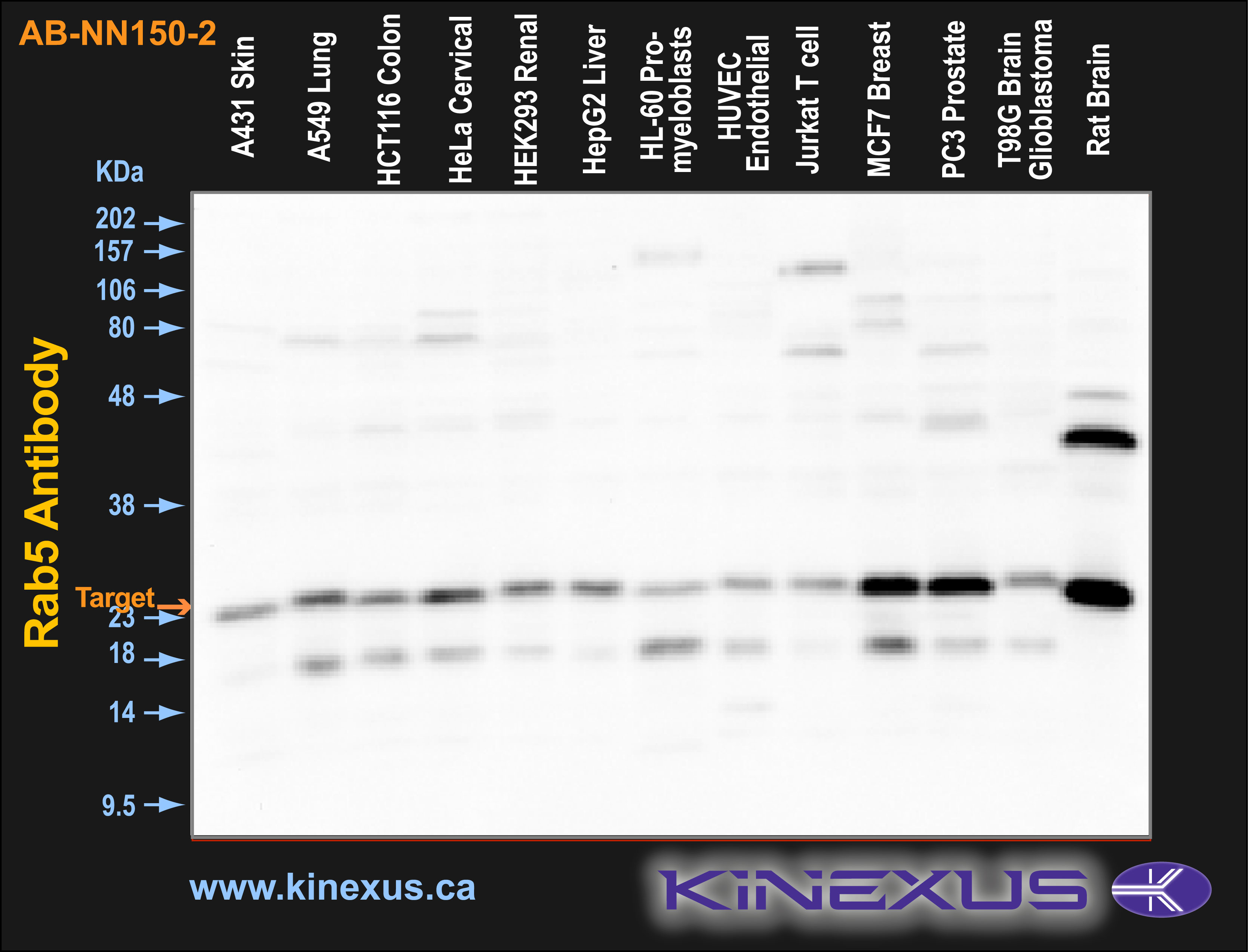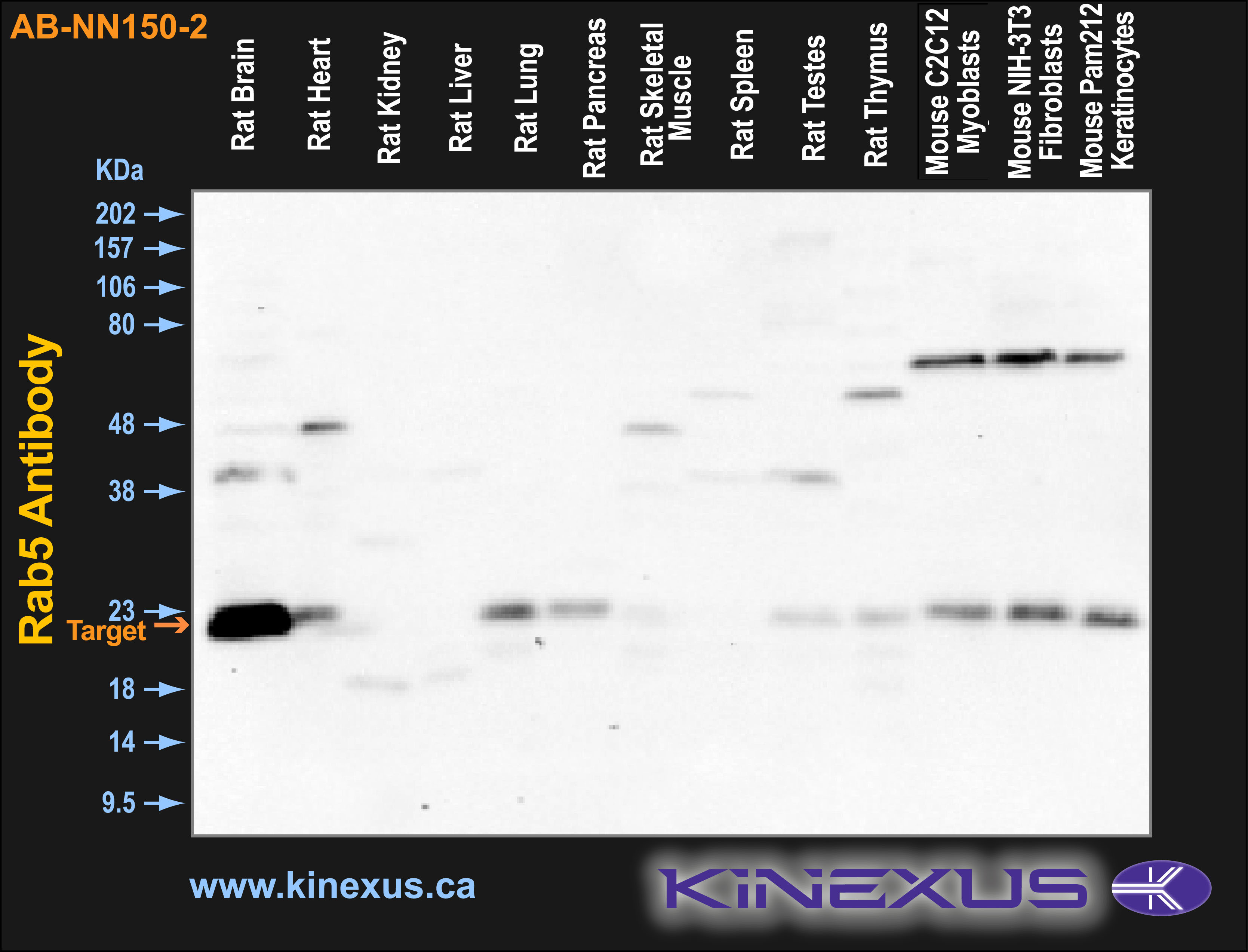Product Name: Rab5
Product Number: AB-NN150
| Size: | 25 µg | Price: | 89.00 | |
| $US |
Target Full Name: Ras-related protein Rab-5A
Target Alias: Rab 5A; RAS associated protein RAB5A; Ras related protein Rab 5 A
Product Type Specific: G (Rab) protein pan-specific antibody
Antibody Code: NN150
Antibody Target Type: Pan-specific
Protein UniProt: P20339
Protein SigNET: P20339
Antibody Type: Polyclonal
Antibody Host Species: Rabbit
Antibody Ig Isotype Clone: N/A
Antibody Immunogen Source: Human Rab5 synthetic peptide conjugated to KLH; identical to dog Rab5 sequence over the residues
Target Alias: Rab 5A; RAS associated protein RAB5A; Ras related protein Rab 5 A
Product Type Specific: G (Rab) protein pan-specific antibody
Antibody Code: NN150
Antibody Target Type: Pan-specific
Protein UniProt: P20339
Protein SigNET: P20339
Antibody Type: Polyclonal
Antibody Host Species: Rabbit
Antibody Ig Isotype Clone: N/A
Antibody Immunogen Source: Human Rab5 synthetic peptide conjugated to KLH; identical to dog Rab5 sequence over the residues
Production Method: Affinity purified
Antibody Modification: Unconjugated. Contact KInexus if you are interest in having the antibody biotinylated or coupled with fluorescent dyes.
Antibody Concentration: 1 mg/ml
Storage Buffer: Phosphate buffered saline, 50% glycerol, 0.09% sodium azide
Storage Conditions: For long term storage, keep frozen at -40°C or lower. Stock solution can be kept at +4°C for more than 3 months. Avoid repeated freeze-thaw cycles.
Product Use: Western blotting | ICC/Immunofluorescence
Antibody Dilution Recommended: WB (1:1000), ICC/IF (1:150); optimal dilutions for assays should be determined by the user.
Antibody Modification: Unconjugated. Contact KInexus if you are interest in having the antibody biotinylated or coupled with fluorescent dyes.
Antibody Concentration: 1 mg/ml
Storage Buffer: Phosphate buffered saline, 50% glycerol, 0.09% sodium azide
Storage Conditions: For long term storage, keep frozen at -40°C or lower. Stock solution can be kept at +4°C for more than 3 months. Avoid repeated freeze-thaw cycles.
Product Use: Western blotting | ICC/Immunofluorescence
Antibody Dilution Recommended: WB (1:1000), ICC/IF (1:150); optimal dilutions for assays should be determined by the user.
Antibody Potency: Medium potency. Detects a ~26 kDa protein in cell and tissue lysates by Western blotting.
Antibody Species Reactivity: Human | Mouse | Rat | Bovine | Monkey
Antibody Positive Control: 1 µl/ml of SPC-168 was sufficient for detection of Rab5 in 15 µg of HeLa lysate by ECL immunoblot analysis using Donkey anti-rabbit IgG:HRP as the secondary antibody.
Antibody Specificity: Very high
Related Product 1: Rab1B pan-specific antibody (Cat. No.: AB-NN378-1)
Antibody Species Reactivity: Human | Mouse | Rat | Bovine | Monkey
Antibody Positive Control: 1 µl/ml of SPC-168 was sufficient for detection of Rab5 in 15 µg of HeLa lysate by ECL immunoblot analysis using Donkey anti-rabbit IgG:HRP as the secondary antibody.
Antibody Specificity: Very high
Related Product 1: Rab1B pan-specific antibody (Cat. No.: AB-NN378-1)
Scientific Background: Rab5 is a 24kDa member of the Rab family of small guanosine triphosphatases (GTPases), Ras superfamily. Rab GTPases are central regulators of membrane trafficking in the eukaryotic cell. Their regulatory capacity depends on their ability to cycle between the GDP -bound inactive and GTP-bound active states. This conversion is regulated by GDP/GTP exchange factors (GEPs), GDP dissociation inhibitors (GDIs) and GTPase-activating proteins (GAPs) (1, 2). Activation of a Rab protein is coupled to its association with intracellular membranes, allowing it to recruit downstream effector proteins to the cytoplasmic surface of a subcellular compartment (3). Through these proteins, Rab GTPases regulate vesicle formation, actin- and tubulin-dependent vesicle movement, and membrane fusion(1). Rab proteins contain conserved regions involved in guanine-nucleotide binding, and hyper variable COHO-terminal domains with a cysteine motif implicated in subcellular targeting. Post-translational modification of the cysteine motif with one or two geranyl groups is essential for the membrane association and correct intracellular localization of Rab proteins(3). Each Rab shows a characteristic subcellular distribution (4).
In particular, Rab5 is ubiquitously expressed in human tissues. It localizes mainly to early endosomes, but is also present on the plasma membrane. It regulates the fusion between endocytic vesicles and early endosomes, as well as the homotypic fusion between early endosomes (5). Among the proteins recruited by the GTP-bound active Rab5 are Rabaptin-5 and EEA1 (6). Anti-Rab5 may be used as an early endosome marker.
Figure 1. Immunoblotting of various cell lines with AB-NN150-2 antibody at a 500 X dilution. The target protein Rab5 is indicated. Each lane was loaded with 15 µg of cell lysate protein. The max signal count was 24045.
Figure 2. Immunoblotting of various tissue lines with AB-NN150-2 antibody at a 500 X dilution. The target protein Rab5 is indicated. Each lane was loaded with 15 µg of tissue lysate protein. The max signal count was 18606.
References
[1] Stenmark H., and Olkkonen V.M. (2001) Genome Biol. 2: 3007.1-3007.7.
[2] Ali B.R. et al. (2004) J. Cell Sci. 117: 6401-6412.
[3] Zerial M., and McBride H. (2001) Nat. Rev. Mol. Cell Biol. 2: 107-117.
[4] Sonnichsen B. et al. (2000) J. Cell Biol. 149: 901-913.
[5] Woodman P.G. (2000) Traffic. 1: 695-701.
[1] Stenmark H., and Olkkonen V.M. (2001) Genome Biol. 2: 3007.1-3007.7.
[2] Ali B.R. et al. (2004) J. Cell Sci. 117: 6401-6412.
[3] Zerial M., and McBride H. (2001) Nat. Rev. Mol. Cell Biol. 2: 107-117.
[4] Sonnichsen B. et al. (2000) J. Cell Biol. 149: 901-913.
[5] Woodman P.G. (2000) Traffic. 1: 695-701.
© Kinexus Bioinformatics Corporation 2017



